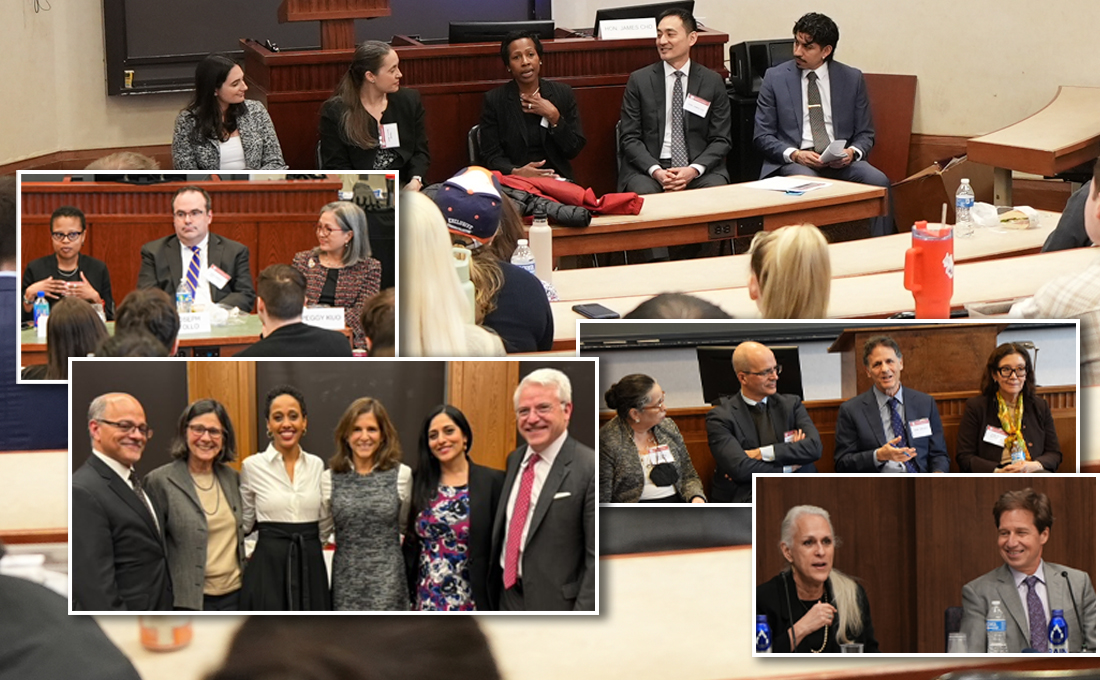Students Learn and Meet with Prominent Judges from the Eastern District of New York at EDNY Day

Twenty-two federal judges from the U.S. District Court for the Eastern District of New York (EDNY) took part in EDNY Day at Brooklyn Law School on Wednesday, March 6. The judges, who serve as Article III judges, magistrate judges, and bankruptcy judges visited eight classes and several small discussion groups throughout the day, spoke at lunchtime sessions, and participated in an evening town hall meeting and reception.
EDNY Day has become an annual tradition at the Law School. Students have the unique opportunity to meet and learn from prominent federal judges, including those who also are alumni of the Law School. That includes the Hon. Ramon E. Reyes Jr. ’92, a member of the Board of Trustees and a key organizer of the event with Law School professors Jodi Balsam, Stacy Caplow, Maryellen Fullerton, Alexis Hoag-Fordjour, and Joy Kanwar.
More than 200 students attended the four lunchtime panel discussions with judges on Working in Chambers: Interning and Clerking; Effective Advocacy in the Courtroom; Judicial Decision-making: Sentencing, Pretrial Detention, Diversion; and Well-being in Law School and Law Practice. Among the sessions was one led by EDNY Chief Bankruptcy Judge Alan S. Trust, who provided students with an introduction to bankruptcy law and practice.
The theme for the town hall, which was held in the Moot Court Room, was “Paths to the Bench,” and was moderated by President and Joseph Crea Dean David D. Meyer. Former Chief Judge Dora Irizarry was joined on the panel by fellow judges Lois Bloom, Lee Dunst, Peggy Kuo, Ramon Reyes, and Elizabeth Stong.
Meyer kicked off the town hall with thanks to all the judges who took part. “This day represents just what a deep, multi-dimensional partnership we are so fortunate to have between the Law School and EDNY,” he said. “It extends far beyond this day to having many members of the court who are our adjunct faculty and mentors to our students as externs or law clerks and invite our students to go to the court to see proceedings.”
In answer to Meyer’s question, “When you were in law school, did you have the ambition to become a judge?” the judges were unanimous in saying that it wasn’t a part of their plans when they were starting out. But they all spoke of the importance, inspiration, and encouragement of mentors they had along the way, and of how that led them to pursue a judgeship.
Irizarry and Kuo spoke of being minority women in a then-male-dominated profession, and of the importance of having mentors that believed in them (the longtime DA Robert Morgenthau, in Irizarry’s case) and of taking career risks (for Kuo, leaving the U.S. Department of Justice to prosecute war crimes at the U.N. International Criminal Tribunal for the former Yugoslavia in The Hague).
Reyes recalled his clerkship with former EDNY judge and Brooklyn Law School dean, the late Hon. David Trager. “Seeing the passion for what he did was when I thought, I want to be that, I want to do that,” he said.
Stong, whose path led from litigation partner and associate at major law firms to becoming a bankruptcy judge for the EDNY, said she found unexpected inspiration in hearing now-retired Judge Robert Gerber, of the Southern District of New York speak. “He talked of his work on complex problems with companies having financial difficulties, and of helping families save their homes, and of ordinary people who may actually be your neighbors getting a second chance,” Stong said.
For Dunst, what he called his “long and winding road” to a judgeship led from being a litigation partner at Gibson Dunn to serving as A.U.S.A. in the EDNY, where, working with Judge Reena Raggi (now a U.S. Circuit Judge of the U.S. Court of Appeals for the Second Circuit), he said, “I was blown away by her as a person and as a jurist and through the way she approached things. I wanted to be her!”
Bloom recalled her “unconventional background,” which included having a SUNY law degree and “working in the trenches” after law school as a staff attorney for the West Side SRO Law project, fighting for the rights of tenants who were indigent, and then as head of the Pro Se Office of the Southern District. “Have meaningful relationships and do meaningful work,” Bloom encouraged the students. “Those are the keys, and nobody gives you the keys. That’s for you to do for yourself.”
The EDNY (consisting of Kings, Queens, Richmond, Nassau, and Suffolk counties) has a diverse population of 8 million people and encompasses major international air and seaports and commercial activity. It is one of the most active federal courts in the country for cases involving national security, complex white-collar crimes, bankruptcy, civil rights, public corruption, and more.
With the court’s main building located just several blocks from the Law School, the EDNY offers students a range of opportunities to enhance their law school experience and interact with federal judges, federal prosecutors and defense attorneys, and court staff.
Many alumni of the Law School over the years have served as law clerks for members of the EDNY bench, including Ramsha Ansari ’20, who clerks for the Hon. Marcia Henry, and joined the judge for the Working in Chambers discussion.
Five of the participating EDNY judges are also among the Law School’s respected adjunct professors: Chief Judge Margo Brodie, and judges James Cho, Marcia Henry, Ramon Reyes, and Elizabeth Stong. Our thanks to them and to their fellow judges who made EDNY Day a great success: Frederic Block, Lois Bloom, Pamela Chen, Lee Dunst, Nicholas Garaufis, Hector Gonzalez, Dora Irizarry, Rachel Kovner, Peggy Kuo, Robert Levy, Joseph Marutollo, Kiyo Matsumoto, Orelia Merchant, Taryn Merkl, Natasha Merle, Alan S. Trust, and James Wicks.
View pictures of EDNY Day Town Hall: https://www.flickr.com/photos/brooklynlawschool/albums/72177720315275227/